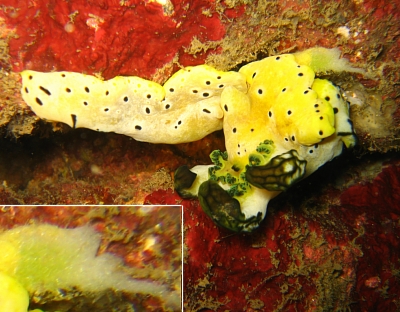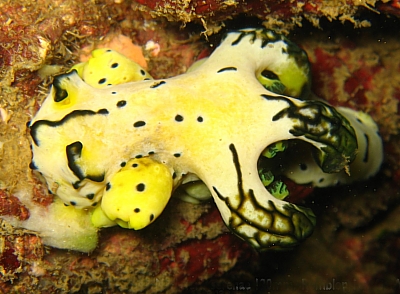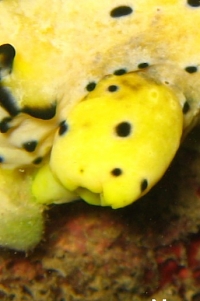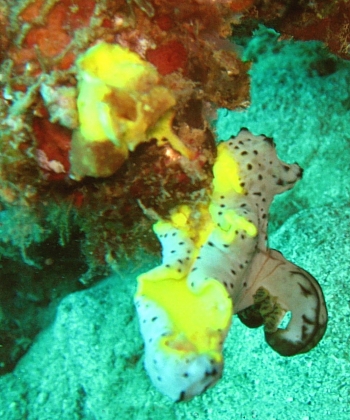Notodoris serenae from Philippines
July 21, 2008
From: Gaetan White

Concerning message #19974:
Dear Bill
I found these two Notodoris serenae and a dozen others, whilst re-exploring around the Romblon islands, (Tablas, Romblon, Sibuyan), Philippines, (one of my favorite nudy, squid and sea-horse observation spots in Asia), during April 2008.
On Sibuyan island, the dramatic increase of heavy maritime traffic with its nimby bilging, deforestation in the north, cyanide/naphthalene fishing mainly by Mindanao refugees, (giant squid hunting specialists, but not many of them left either!), agricultural products on mango (the whole production is ripe the same week!), coconut, rice etc plantations, 2005-7 mercury/acid use in illegal gold rush mines in the north east, opening of manganese-nickel (gold) mine by Australo-Can-Phil. remake of 'Marinduque tailings' operators on the east, foreigners building X20 cost price houses for 2 months yearly use with no water (abandoned after 2nd year!) on unlivable coastlines, are taking their toll. In the last 24 months, corals and sponges have decreased by 25% and are being covered in algae; Cladophora sp., cyanobacteria Lyngbya sp. and brown/red slime all over the place. I'm aware that Nudib. populations vary, but in the Romblons they're decreasing in numbers and changing in species.
Changes are interesting to watch. Underwater adaptations can be comparatively rapid. Notodoris serenae are getting bigger and more numerous. Before they were rare in the area, only found in canyons and entrances of caves, now they are everywhere and even quite deep, 2 to 25 meters. Nov. 2006 typhoon certainly brought in new strains. No black bands around foot. I've found them mating, laying eggs, feeding, but in mid April 2008 from 'Blue hole', Carman, Tablas island, through 'Agutay lighthouse canyons', Romblon island, on to 'Balabag bay, Sibuyan island and other intermediate sites, 140km. round trip, I observed nearly all of them were 'stuck' stationary on a rubbery yellow mass exuding from the two blown up lateral 'pouches' behind their head. Not the normal egg ribbons. Not residues of the yellow Leucetta chagosensis sponge (which incidentally I've never seen them stay or feed on, but always on or around the encrusting bordeaux-red stuff (or under some, on sand-coral rubble) and feeding on something on it, as in my photos (and that goes for other places and countries).
24 hrs after, on the next observation dive there was nothing left, no Notodoris serenae, no yellow gunge! just a film of white slime. What are the pouches? What's the yellow gunge that exudes from them and why?
What's the bordeaux-red stuff they are on, sponge or coral?
In message #4492 they are on what appears to be Leucetta chagosensis sponge, but I'm not sure they are feeding on it. From November 2007 to May 2008 specimens were observed in Pulau Weh, Indonesia; Mergui sea, Myanmar; Surin/Similan, Thailand; Busuanga and Romblons Philippines.
Upper Photos: Location: Agutay lighthouse canyons, Romblon island, Philippines. 12 m, 16 april 2008. Length: 120 mm, W/Temp: 28 C degree
Photo: G.A. White. Lower Photo: Specimen prised off by me (Sorry).
Balabag Bay bommies, Sibuyan island, Philippines. 15 m, 21 april 2008, Length: 120 mm, W/Temp: 28 C degree. Photo: G.A. White
Best Regards,
Gaetan White
gaetan.white@wanadoo.fr



Dear Gaetan,
I am sure there is much environmental destruction occurring in the places you have visited, but unless you have regular observations over a long period, it's difficult to know whether what you saw in Sibuyan Island is permanent environmental damage or part of a seasonal cycle. In tropical waters a rapid influx of freshwater from flooded rivers can dramatically change local ecosytems in a few days, but if it is part of a seasonal cycle things seem recover quite quickly. Your example may be an environmental catastrophe but I guess only time will tell.
There seems to be some bits of the yellow sponge they feed on in all your photos [I have added a close-up in the top photo]. Its apparent absence may be because the nudibranchs have just about eaten all the colonies. Concerning the yellow 'gunge'. Notodoris serenae has a bright yellow foot so much of the colour in your lower photo is the bright yellow sole of the foot. The yellow mucus-looking secretion on the sponge and the foot is probably a defensive secretion produced by the animal. I am puzzled by the 'pouches' in the middle photo. Perhaps the large animal has crawled over a smaller one already feeding on the sponge beneath them? I am afraid I can only guess. I guess its important to a to do a bit of gentle 'poking and prodding' when you see something peculiar. If you didn't notice it unitl you looked at your photos then it has to remain one of 'life's little mysteries'.
The 'bordeaux-red stuff ' certainly looks like a sponge, but I am pretty sure it is not a calcareous sponge, which are what species of Notodoris feed on.
Best wishes,
Bill Rudman
Related messages
-
Notodoris serenae from Sabah, Malaysia
From: Richard Swann, June 19, 2007 -
Notodoris serenae from Malaysia
From: Kerem Turker, February 10, 2006 -
Re: Notodoris serenae from Indonesia
From: Douglas Hansen, December 24, 2004 -
Notodoris serenae from Solomon Ids
From: Bruce Potter, October 24, 2003 -
Notodoris serenae from Okinawa
From: Kaoru Imagawa, June 28, 2003 -
Notodoris serenae from the Solomon Ids
From: Bruce Potter, September 20, 2002 -
Notodoris serenae from Moyo Island, Indonesia
From: Walabha Sinbul, August 10, 2002 -
Notodoris serenae from Papua New Guinea
From: Marli Wakeling, October 8, 2001 -
Notodoris serenae from Tufi, Papua New Guinea
From: Des Paroz, October 2, 2001 -
Notodoris serenae from Papua New Guinea
From: Stuart Hutchison, June 5, 2001 -
Notodoris serenae from Solomon Ids
From: Bruce Potter, October 27, 2000
